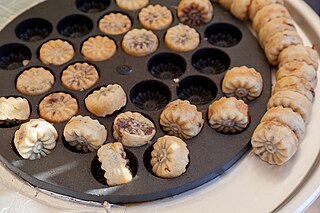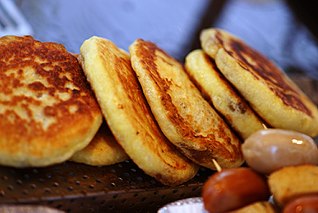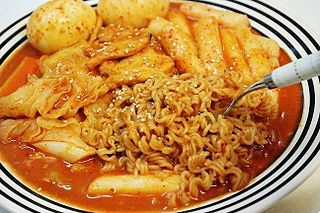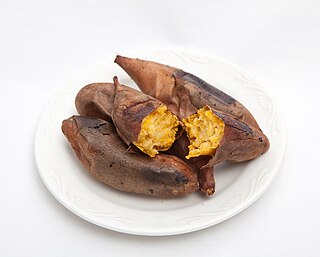 W
WBeondegi (번데기), literally "pupa", is a Korean street food made with silkworm pupae. The boiled or steamed snack food is served in paper cups with toothpick skewers.
 W
WBungeo-ppang is a fish-shaped pastry stuffed with sweetened red bean paste, which originated from the Japanese taiyaki. One of South Korea's most popular winter street foods, the snack is often sold at street stalls, grilled on an appliance similar to a waffle iron but with a fish-shaped mold. Red bean paste is the standard filling but many bungeo-ppang sold as street food are filled with pastry cream, pizza toppings, chocolate and others. Usually, it costs about 1,000 won (KRW) for three bungeo-ppang. However, small bungeo-ppang costs 1,000 won for five and large bungeo-ppang costs 2,000 won for one, indicating that the price range varies depending on the size.
 W
WChapssal doughnuts are Korean doughnuts made with glutinous rice flour. The mildly sweet doughnuts are often filled with sweetened red bean paste and coated with the mixture of sugar and cinnamon powder. Glutinous rice flour dough creates the crunchy outside texture and chewy inside texture. Beside food stalls in traditional markets, the doughnuts are also sold through franchise bakeries such as Dunkin' Donuts Korea and Paris Baguette.
 W
WDak-kkochi is a popular South Korean street food consisting of small pieces of chicken and scallions grilled on a skewer.
 W
WGarae-tteok (가래떡) is a long, cylindrical tteok made with non-glutinous rice flour. Grilled garae-tteok is sometimes sold as street food. Thinly sliced garae-tteok is used for making tteokguk, a traditional dish eaten during the celebration of the Korean New Year. The world record of the longest garaetteok was achieved in Dangjin, South Korea in 2018, with 5,080 metres (16,670 ft).
 W
WGukhwa-ppang is a flower-shaped pastry stuffed with sweetened red bean paste. It is a warm street food sold throughout Korea. It is grilled in an appliance similar to a waffle iron, but with flower-shaped molds.
 W
WGyeran-ppang is a warm street snack sold throughout South Korea. The fluffy, oblong-shaped loaf of bread is sweet and savory with a whole egg inside the pancake dough.
 W
WHodu-gwaja, commonly translated as walnut cookies, walnut cakes, and walnut pastries, is a type of cookie originated from Cheonan, South Korea. It is also known by the name hodo-gwaja in and outside Korea.
 W
WHoppang is a warm snack that is sold throughout South Korea. It is a convenience food version of jjinppang and is typically filled with smooth, sweetened red bean paste.
 W
WHotteok, sometimes called Hoeddeok, is a type of filled Korean pancake; it is a snack from Korean cuisine and is a popular street food in South Korea.
 W
WJjinppang is a steamed bun, typically filled with red bean paste with bits of broken beans and bean husk. Traditional jjinppang is made of sourdough fermented using the yeast in makgeolli, but younger varieties such as hoppang are often made without fermentation. Warm jjinppang is softer than baked breads due to the higher moisture content, but it hardens as it cools. Thus it is recommended to eat while the bun is still hot. Hardened jjinppang can be steamed again before eaten.
 W
WJumeok-bap or rice ball or Korean style onigiri is a Korean rice dish made from a lump of cooked rice made into a round loaf the shape of a fist. Rice balls are a common item in dosirak and often eaten as a light meal, between-meal snack, street food, or an accompaniment to spicy food. The commercialization of Jumeok-bap began in earnest in 1990, when Japanese cuisine gradually spread to Korea and Onigiris were released. Although it did not receive special attention in the early years, it gained popularity as an inexpensive, easy-to-follow food during the 1997 Asian financial crisis. In the 2010s, a variety of forms of Jumeok-bap were released, including a round-shaped onigiri and a rice burger in the shape of a hamburger.
 W
WKkochi (꼬치) is a category of Korean food cooked on skewers. The word kkochi means "skewer" in Korean.
 W
WKkul-tarae, also known as Korean court cake, is a Korean dessert and a variation of Dragon's beard candy which originated in China. A hard dough of honey-maltose mixture is kneaded, twisted, stretched and pulled into skeins of silky threads, in which assorted candied nuts, chocolate, or other fillings are wrapped. Though commonly known and marketed as treats eaten in the royal court of the Chosun dynasty, this is actually incorrect. The name kkul-tarae was trademarked in November 7th of 2000 with intent to sell dessert similar to Dragon's beard candy in Korea.
 W
WKorokke is the Japanese name for a deep-fried yōshoku dish originally related to a French dish, the croquette. Korokke is made by mixing cooked chopped meat, seafood, or vegetables with mashed potato or white sauce, usually shaped like a flat patty, rolling it in wheat flour, eggs, and Japanese-style breadcrumbs, then deep-frying this until brown on the outside.
 W
WMandu are dumplings in Korean cuisine. Mandu can be steamed, boiled, pan-fried, or deep-fried. The styles also vary across regions in Korean Peninsula. Mandu were long part of Korean royal court cuisine, but are now found in supermarkets, restaurants, and snack places such as pojangmacha and bunsikjip throughout Korea.
 W
WRabokki (라볶이) is a type of tteokbokki, with added ramyeon noodles. It is a street food commonly sold in bunsikjip. As other tteokbokki dishes, eomuk and boiled eggs are a common addition. Cream sauce or western-style chili sauce may be used instead of gochujang.
 W
WRoasted chestnut is a popular autumn and winter street food in East Asia, Europe, and New York City. Asian chestnuts as well as European chestnuts can be used.
 W
WRoasted sweet potato is a popular winter street food in East Asia.
 W
WSo-tteok so-tteok is a popular South Korean street food consisting of skewered and fried garae-tteok and vienna sausage brushed with several sauce include mustard and spicy gochujang-based sauce.
 W
WSundae is a type of blood sausage in Korean cuisine. It is a popular street food in both North and South Korea, generally made by steaming cow or pig's intestines stuffed with various ingredients.
 W
WTakoyaki (たこ焼き or 蛸焼) or "octopus balls" is a ball-shaped Japanese snack made of a wheat flour-based batter and cooked in a special molded pan. It is typically filled with minced or diced octopus (tako), tempura scraps (tenkasu), pickled ginger, and green onion (negi). The balls are brushed with takoyaki sauce and mayonnaise, and then sprinkled with green laver (aonori) and shavings of dried bonito (katsuobushi).
 W
WTongdak is a variety of chicken, prepared by deep-frying a whole chicken. It was a popular food in 1970s, being the only kind of fried chicken sold in Korea at that time. It is considered as the proto-Korean fried chicken.
 W
WTornado potatoes, also called twist potatoes or tornado fries, are a popular street food in South Korea, originally developed by Jeong Eun Suk of Agricultural Hoeori Inc. It is a deep fried spiral-cut whole potato on a skewer, brushed with various seasonings such as onion, cheese, or honey. Some varieties have spliced sausages in between.
 W
WTteok-galbi (떡갈비) or grilled short rib patties is a Korean beef dish made with minced beef short ribs. Originally a royal dish, tteok-galbi is now a local specialty of Gyeonggi Province in the central-west region and South Jeolla Province in the south-west region of the Korean Peninsula.
 W
WTteok-kkochi is a popular South Korean street food consisting of skewered and fried tteok brushed with spicy gochujang-based sauce.
 W
WTteokbokki (떡볶이), or simmered rice cake, is a popular Korean food made from small-sized garae-tteok called tteokmyeon or commonly tteokbokki-tteok. Eomuk, boiled eggs, and scallions are some common ingredients paired with tteokbokki in dishes. It can be seasoned with either spicy gochujang or non-spicy ganjang -based sauce; the former is the most common form, while the latter is less common and sometimes called gungjung-tteokbokki.